Fungal Phytopathogenic Spore First Assessment in an Olive Orchard of Northwestern Spain
Abstract
1. Introduction
2. Materials and Methods
3. Results
4. Discussion
5. Conclusions
Author Contributions
Funding
Data Availability Statement
Conflicts of Interest
References
- Nigro, F.; Antelmi, I.; Sion, V. Integrated control of aerial fungal diseases of olive. Acta Hortic. 2018, 327–332. [Google Scholar] [CrossRef]
- Galán, C.; García-Mozo, H.; Vázquez, L.; Ruiz-Valenzuela, L.; Díaz de la Guardia, C.; Trigo, M.M. Heat requirement for the onset of the Olea europaea L. pollen season in several sites of Andalusia and the effect of the expected future climate change. Int. J. Biometeorol. 2005, 49, 184–188. [Google Scholar] [CrossRef] [PubMed]
- Garrido, A.; Fernández-González, M.; Vázquez-Ruiz, R.A.; Rodríguez-Rajo, F.J.; Aira, M.J. Reproductive Biology of Olive Trees (Arbequina cultivar) at the Northern Limit of Their Distribution Areas. Forests 2021, 12, 204. [Google Scholar] [CrossRef]
- Graniti, A. Olive scab: A review. EPPO Bull. 1993, 23, 377–384. [Google Scholar] [CrossRef]
- González-Domínguez, E.; Armengol, J.; Vittorio, R. Biology and Epidemiology of Venturia Species Affecting Fruit Crops: A Review. Front. Plant Sci. 2017, 8, 1496. [Google Scholar] [CrossRef]
- Viruega, J.R.; Moral, J.; Roca, L.F.; Navarro, N.; Trapero, A. Spilocaea oleagina in Olive groves of Southern Spain: Survival, Inoculum Production, and Dispersal. Plant Dis. 2013, 97, 1549–1556. [Google Scholar] [CrossRef][Green Version]
- López-Doncel, L.M.; Viruega, J.R.; Trapero-Casas, A. Respuesta del olivo a la inoculación con Spilocaea oleagina. Bol. Sanid. Veg. Plagas 2000, 26, 349–363. [Google Scholar]
- Cacciola, S.; Faedda, R.; Sinatra, F.; Agosteo, G.; Schena, L.; Frisullo, S.; Magnano di San Lio, G. Olive anthracnose. J. Plant Pathol. 2012, 94, 29–44. [Google Scholar]
- Brancher, N.; Pérez, B.A.; Matías, C.; Otero, L.; Oriolani, E.; Aybar, V.E.; Roca, M. Olive (Olea europea L.) pathologies and pests in Catamarca province, Argentina. Acta Hortic. 2008, 949, 317–321. [Google Scholar] [CrossRef]
- Duarte, H.S.S.; Cabral, P.G.C.; Pereira, O.L.; Zambolim, L.; Gonçalves, E.D.; Vieira Neto, J.; Zambolim, E.M.; Sergeeva, V. First report of anthracnose and fruit mummification of olive fruit (Olea europaea) caused by Colletotrichum acutatum in Brazil. Plant Pathol. 2010, 59, 1170. [Google Scholar] [CrossRef]
- Acosta, D.R. Investigaciones fitopatológicas. Min. Ind. Dir. Agron. Publ. Mens. 1932, 4, 1–18. [Google Scholar]
- Pontis, R.E.; Hansen, H.N. Olive anthracnose in the United States. Phytopathology 1942, 32, 642–644. [Google Scholar]
- Bompeix, G.; Julio, E.V.R.; Phillips, D.H. Glomerella cingulate (Stoneman) Spaulding et V. Schrenk. In European Handbook of Plant Diseases; Smith, I.M., Dunez, J., Lelliot, R.A., Phillips, D.H., Archer, S.A., Eds.; Blackwell Scientific Publications: Oxford, UK, 1988; pp. 325–327. [Google Scholar]
- Iliadi, M.K.; Tjamos, E.; Antoniou, P.; Tsitsigiannis, D.I. First report of Colletotrichum acutatum causing anthracnose on olives in Greece. Plant Dis. 2018, 102, 820. [Google Scholar] [CrossRef]
- Agosteo, G.E.; Magnano di San Lio, G.; Frisullo, S.; Cacciola, S.O. Characterisation of the causal agent of olive anthracnose in southern Italy. Acta Hortic. 2002, 586, 713–716. [Google Scholar] [CrossRef]
- Mosca, S.; Li Destri Nicosia, M.G.; Cacciola, S.O.; Schena, L. Molecular analysis of Colletotrichum species in the carposphere and phyllosphere of olive. PLoS ONE 2014, 9, e114031. [Google Scholar] [CrossRef]
- Talhinhas, P.; Neves-Martins, J.; Oliveira, H.; Sreenivasaprasad, S. The distinctive population structure of Colletotrichum species associated with olive anthracnose in the Algarve region of Portugal reflects a host–pathogen diversity hot spot. FEMS Microbiol. Lett. 2009, 296, 31–38. [Google Scholar] [CrossRef]
- Talhinhas, P.; Mota-Capitao, C.; Martins, S.; Ramos, A.P.; Neves-Martins, J.; Guerra-Guimaraes, L.; Várzea, V.; Silva, M.C.; Sreenivasaprasad, S.; Oliveira, H. Epidemiology, histopathology and aetiology of olive anthracnose caused by Colletotrichum acutatum and C. gloeosporioides in Portugal. Plant Pathol. 2011, 60, 483–495. [Google Scholar] [CrossRef]
- Talhinhas, P.; Gonçalves, E.; Sreenivasaprasad, S.; Oliveira, H. Virulence diversity of anthracnose pathogens (Colletotrichum acutatum and C. gloeosporioides complexes) on eight olive cultivars commonly grown in Portugal. Eur. J. Plant Pathol. 2015, 142, 73–83. [Google Scholar] [CrossRef]
- Martín, M.P.; García-Figueres, F. Colletotrichum acutatum and C. gloeosporioides cause anthracnose on olives. Eur. J. Plant Pathol. 1999, 105, 733–741. [Google Scholar] [CrossRef]
- Vucinic, Z.; Latinovic, J.; Metzidakis, I.T.; Voyiatzis, D.G. Colletotrichum gloeosporioides, a new olive (Olea europaea L.) parasite in Yugoslavia. Acta Hortic. 1999, 474, 577–579. [Google Scholar] [CrossRef]
- Gorter, G.J.M.A. Anthracnose fungi of olives. Nature 1956, 178, 1129–1130. [Google Scholar] [CrossRef]
- Achbani, E.A.; Benbouazza, A.; Douira, A. First report of olive anthracnose, caused by Colletotrichum gloeosporioides, in Morocco. Atlas J. Biol. 2013, 2, 171–174. [Google Scholar] [CrossRef]
- Chattaoui, M.; Raya, M.C.; Bouri, M.; Moral, J.; Perez-Rodriguez, M.; Trapero, A.; Msallem, M.; Rhouma, A. Characterization of a Colletotrichum population causing anthracnose disease on olive in northern Tunisia. J. Appl. Microbiol. 2016, 120, 1368–1381. [Google Scholar] [CrossRef] [PubMed]
- Rhouma, A.; Triki, M.A.; Msallem, M. First report of olive anthracnose caused by Colletotrichum gloeosporioides in Tunisia. Phytopathol. Mediterr. 2010, 49, 95–98. [Google Scholar]
- Embaby, E.-S. Anthracnose disease (Colletotrichum sp.) affecting olive fruit quality and its control in Egypt. J. Agric. Technol. 2014, 10, 1289–1306. [Google Scholar]
- Margarita, L.; Porta-Puglia, A.; Quacquarelli, A. Colletotrichum acutatum, nuovo patogeno dell’olivo in Cina e confronto con l’agente della “lebbra” dell’olivo. Ann. Ist. Sperim. Patol. Veg. 1986, 11, 125–133. [Google Scholar]
- Hemmi, T.; Kurata, S. Contributions to the knowledge of anthracnose of plants II, on Gloeosporium olivarum Alm. causing the olive anthracnose. J. Soc. Trop. Agric. Taiwan 1935, 6, 573–583. [Google Scholar]
- Sanei, S.J.; Razavi, S.E. Differentiation of olive Colletotrichum gloeosporioides populations on the basis of vegetative compatibility and pathogenicity. Afr. J. Agric. Res. 2011, 6, 2099–2107. [Google Scholar]
- Sanei, S.J.; Razavi, S.E. Survey of olive fungal disease in north of Iran. Annu. Rev. Res. Biol. 2012, 2, 27–36. [Google Scholar]
- Sharma, R.L.; Kaul, J.L. Field evaluation of fungicide for control of olive anthracnose. Indian J. Mycol. Plant Pathol. 1990, 20, 185–187. [Google Scholar]
- Schena, L.; Mosca, S.; Cacciola, S.O.; Faedda, R.; Sanzani, S.M.; Agosteo, G.E.; Sergeeva, V.; Magnano di San Lio, G. Species of the Colletotrichum gloeosporioides and C. boninense complexes associated with olive anthracnose. Plant Pathol. 2014, 63, 437–446. [Google Scholar] [CrossRef]
- Whitelaw-Weckert, M.; Curtin, S.J.; Huang, R.; Steel, C.C.; Blanchard, C.L.; Roffey, P.E. Phylogenetic relationships and pathogenicity of Colletotrichum acutatum isolates from grape in subtropical Australia. Plant Pathol. 2007, 56, 448–463. [Google Scholar] [CrossRef]
- Talhinhas, P.; Loureiro, A.; Oliveira, H. Olive anthracnose: A yield- and oil quality-degrading disease caused by several species of Colletotrichum that differ in virulence, host preference and geographical distribution. Mol. Plant Pathol. 2018, 19, 1797–1807. [Google Scholar] [CrossRef] [PubMed]
- Oliveira, R.; Moral, J.; Bouhmidi, K.; Trapero, A. Caracterización morfológica y cultural de aislados de Colletotrichum spp. Causantes de la antracnosis del olivo. Bol. Sanid. Veg. Plagas 2005, 31, 531–548. [Google Scholar]
- Moral, J.; Xaviér, C.; Roca, L.F.; Romero, J.; Moreda, W.; Trapero, A. La Antracnosis del olivo y su efecto en la calidad del aceite. Grasas Y Aceites 2014, 65, e028. [Google Scholar] [CrossRef]
- Castellar-Sánchez, M.A. Plagas y enfermedades del olivo (Olea europaea). Prot. Masas For. 2011, 1, 1–20. [Google Scholar]
- Moral, J.; Ávila, L.M.; López-Doncel, M.; Alsalimiya, R.; Oliveira, F.; Gutiérrez, N.; Benali, A.; Roca, L.F.; Navarro, N.; Bouhmidi, K.; et al. Resistencia a los repilos de distintas variedades de olivo. Vida Rural 2005, 208, 34–41. [Google Scholar]
- Nigro, F.; Ippolito, A.; Gallone, P.; Romanazzi, G.; Carmignano, P.; Laccone, G. Cercosporiosis of olive in Apulia and attempts to control the disease. Acta Hortic. 2002, 586, 773–776. [Google Scholar] [CrossRef]
- Govi, G. La Cercosporiosis o Piombatura dell’Olivo. Ann. Sper. Agrar. 1952, 6, 69–80. [Google Scholar]
- Modugno Pettinari, C. Istopatologia causata dal parassitismo di Cercospora cladosporioides Sacc. su olivo. Boll. Della Stn. Patol. Veg. Roma S. III 1960, 18, 65–77. [Google Scholar]
- Nigro, F.; Ferrara, M. Olive cercosporiosis. In Olive Diseases and Disorders; Schena, L., Agosteo, G.E., Cacciola, S.O., Eds.; Research Signpost: Thiruvananthapuram, India, 2011; pp. 247–258. [Google Scholar]
- Ávila, A.; Groenewald, J.Z.; Trapero, A.; Crous, P.W. Characterisation and epitypification of Pseudocercospora cladosporioides, the causal organism of Cercospora leaf spot of olives. Mycol. Res. 2005, 109, 881–888. [Google Scholar] [CrossRef]
- Ávila, A.; Romero, J.; Agusti-Brisach, C.; Benali, A.; Roca, L.F.; Trapero, A. Phenotypic and pathogenic characterization of Pseudocercospora cladosporioides, causal agent of cercospora leaf spot of olives. Eur. J. Plant Pathol. 2020, 156, 45–65. [Google Scholar] [CrossRef]
- Chen, M.-M. Forest Fungi Phytogeography: Forest Fungi Phytogeography of China, North America, and Siberia and International Quarantine of Tree Pathogens; Pacific Mushroom Research and Education Center: Sacramento, CA, USA, 2002; 469p. [Google Scholar]
- Henricot, B.; Gorton, C.; Denton, J.; Denton, G. Pseudocercospora cladosporioides, the cause of leaf spot on olive, a pathogen new to the United Kingdom. Plant Pathol. 2009, 58, 803. [Google Scholar] [CrossRef]
- Holevas, C.D.; Chitzanidis, A.; Pappas, A.C.; Tzamos, E.C.; Psallidas, P.G.; Alivizatos, A.; Panagopoulos, C.; Kyriakopoulou, P.; Bem, F.; Lascaris, D.; et al. Disease agents of cultivated plants observed in Greece from 1981 to 1990. Ann. De L’institut Phytopathol. Benaki 2000, 19, 1–96. [Google Scholar]
- Kamal. Cercosporoid Fungi of India; Bishen Singh Mahendra Pal Singh: Dehra Dun, India, 2010; 351p. [Google Scholar]
- Kobayashi, T. Index of Fungi Inhabiting Woody Plants in Japan-Host, Distribution and Literature; Zenkoku-Noson-Kyoiku Kyokai Publishing Co.: Tokio, Japan, 2007; 1227p. [Google Scholar]
- McKenzie, E.H.C. New plant disease records in New Zealand: Miscellaneous fungal pathogens II. N. Z. J. Crop Hortic. Sci. 1990, 18, 65–73. [Google Scholar] [CrossRef]
- Ávila, A.; Benali, A.; Trapero, A. El emplomado del olivo, una grave enfermedad poco conocida. Vida Rural 2004, 198, 32–36. [Google Scholar]
- Ávila, A.; Trapero, A. El Emplomado del Olivo y del Acebuche; Consejería de Medio Ambiente de la Junta de Andalucía: Sevilla, Spain, 2010; p. 8. [Google Scholar]
- Orriols, I.; Vázquez, I.; Losada, A. Variedades gallegas. Terruños 2006, 16, 21–22. [Google Scholar]
- Galán, C.; Cariñanos, P.; Alcázar, P.; Domínguez, E. Spanish Aerobiology Network (REA): Management and Quality Manual; University of Córdoba Publication Service: Córdoba, Spain, 2007; p. 61. [Google Scholar]
- Galán, C.; Ariatti, A.; Bonini, M.; Clot, B.; Crouzy, B.; Dahl, A.; Fernandez-González, D.; Frenguelli, G.; Gehrig, R.; Isard, S.; et al. Recommended terminology for aerobiological studies. Aerobiologia 2017, 33, 293–295. [Google Scholar] [CrossRef]
- Meier, U. Growth Stages of Mono- and Dicotyledonous Plants, BBCH Monograph, 2nd ed.; Federal Biological Research Centre for Agriculture and Forestry: Bonn, Germany, 2001. [Google Scholar]
- Sanz-Cortés, F.; Martínez-Calvo, J.; Badenes, M.L.; Bleiholder, H.; Hack, H.; Yacer, G.; Meier, V. Phenological growth stages of olive trees (Olea europaea). Ann. Appl. Biol. 2002, 140, 151–157. [Google Scholar] [CrossRef]
- González-Fernández, E.; Kennedy, R.; Osborn, R.; Fernández-González, M.; Rodríguez-Rajo, F.J. Botrytis cinerea airborne conidia and their germination ability assessed by immunological methods in a NW Spain vineyard. Agronomy 2021, 11, 1441. [Google Scholar] [CrossRef]
- Carisse, O.; Savary, S.; Willocquet, L. Spatiotemporal relationships between disease development and airborne inoculum in unmanaged and managed Botrytis leaf blight epidemics. Phytopathology 2008, 98, 38–44. [Google Scholar] [CrossRef] [PubMed]
- González-Fernández, E.; Piña-Rey, A.; Fernández-González, M.; Aira, M.J.; Rodríguez-Rajo, F.J. Identification and evaluation of the main risk periods of Botrytis cinerea infection on grapevine based on phenology, weather conditions and airborne conidia. J. Agric. Sci. 2020, 158, 88–98. [Google Scholar] [CrossRef]
- Fernández-González, M.; Piña-Rey, A.; González-Fernández, E.; Aira, M.J.; Rodríguez-Rajo, F.J. First assessment of Goidanich Index and aerobiological data for Plasmopara viticola infection risk management in north-west Spain. J. Agric. Sci. 2019, 157, 129–139. [Google Scholar] [CrossRef]
- Piña-Rey, A.; González-Fernández, E.; Fernández-González, M.; Lorenzo, M.N.; Rodríguez-Rajo, F.J. Climate change impacts assessment on wine-growing bioclimatic transition areas. Agriculture 2020, 10, 605. [Google Scholar] [CrossRef]
- Lamichhane, J.R.; Barzman, M.; Booij, K.; Boonekamp, P.; Desneux, N.; Huber, L.; Kudsk, P.; Langrell, S.R.H.; Ratnadass, A.; Ricci, P.; et al. Robust cropping systems to tackle pests under climate change. Agron. Sustain. Dev. 2015, 35, 443–459. [Google Scholar] [CrossRef]
- Huber, L.; Gillespie, T.J. Modeling Leaf Wetness in Relation to Plant Disease Epidemiology. Ann. Rev. Phytopathol. 1992, 30, 553–577. [Google Scholar] [CrossRef]
- Juroszek, P.; von Tiedemann, A. Potential strategies and future requirements for plant disease management under a changing climate. Plant Pathol. 2011, 60, 100–112. [Google Scholar] [CrossRef]
- Huang, C.; Li, N.; Zhang, Z.; Liu, Y.; Chen, X.; Wang, F.; Chen, Q. What Is the Consensus from Multiple Conclusions of Future Crop Yield Changes Affected by Climate Change in China? Int. J. Environ. Res. Public Health 2020, 17, 9241. [Google Scholar] [CrossRef]
- Sergeeva, V.; Braun, U.; Spooner-Hart, R.; Nair, N.G. Observations on spot caused by Fusicladium oleagineum on olives (Olea europaea) in New South Wales, Australia. Australas. Plant Dis. Notes 2009, 4, 26–28. [Google Scholar]
- Moral, J.; Trapero, A. Mummified fruit as a source of inoculums and disease dynamics of olive anthracnose caused by Colletotrichum spp. Phytopathology 2012, 102, 982–989. [Google Scholar] [CrossRef]
- Schena, L.; Abdelfattah, A.; Mosca, S.; Destri Nicosia, M.G.; Agosteo, G.E.; Cacciola, S.O. Quantitative detection of Colletotrichum godetiae and C. acutatum sensu stricto in the phyllosphere and carposphere of olive during four phenological phases. Eur. J. Plant Pathol. 2017, 149, 337–347. [Google Scholar] [CrossRef]
- Almaguer, M.; Fernández-González, M.; Díaz, L.; Sánchez, K.C.; Rodríguez-Rajo, F.J.; Aira, M.J. Aspergillus and Penicillium spores as urban pathogens of the Havana atmosphere, Cuba. Aerobiologia 2021, 37, 767–783. [Google Scholar] [CrossRef]
- Almaguer, M.; Fernández-González, M.; Díaz, L.; Sánchez, K.C.; Rodríguez-Rajo, F.J.; Aira, M.J. Assessment of airborne Curvularia propagules in the atmosphere of Havana, Cuba. Aerobiologia 2021, 37, 53–69. [Google Scholar] [CrossRef]
- Fernández-González, M.; Rodríguez-Rajo, F.J.; Jato, V.; Aira, M.J. Incidence of fungals in a vineyard of the Denomination of Origin Ribeiro (Ourense—north -western Spain). Ann. Agric. Environ. Med. 2009, 16, 263–271. [Google Scholar]
- Romero, J.; Moral, J.; Gonzalez-Dominguez, E.; Agustí-Brisach, C.; Roca, L.F.; Rossi, V.; Trapero, A. Logistic models to predict olive anthracnose under field conditions. Crop Prot. 2021, 148, 105714. [Google Scholar] [CrossRef]
- Moral, J.; Oliveira, R.; Trapero, A. Elucidation of the disease cycle of olive anthracnose caused by Colletotrichum acutatum. Phytopathology 2009, 99, 548–556. [Google Scholar] [CrossRef]
- Del Moral, J.; Medina, D. El “repilo plomizo” del olivo causado por Cercospora cladosporioides Sacc., enfermedad presente en España. Bol. Sanid. Veg. Plagas 1985, 11, 31–36. [Google Scholar]
- Cortiñas Rodríguez, J.A.; González-Fernández, E.; Fernández-González, M.; Vázquez-Ruiz, R.A.; Aira, M.J. Fungal Diseases in Two North-West Spain Vineyards: Relationship with Meteorological Conditions and Predictive Aerobiological Model. Agronomy 2020, 10, 219. [Google Scholar] [CrossRef]

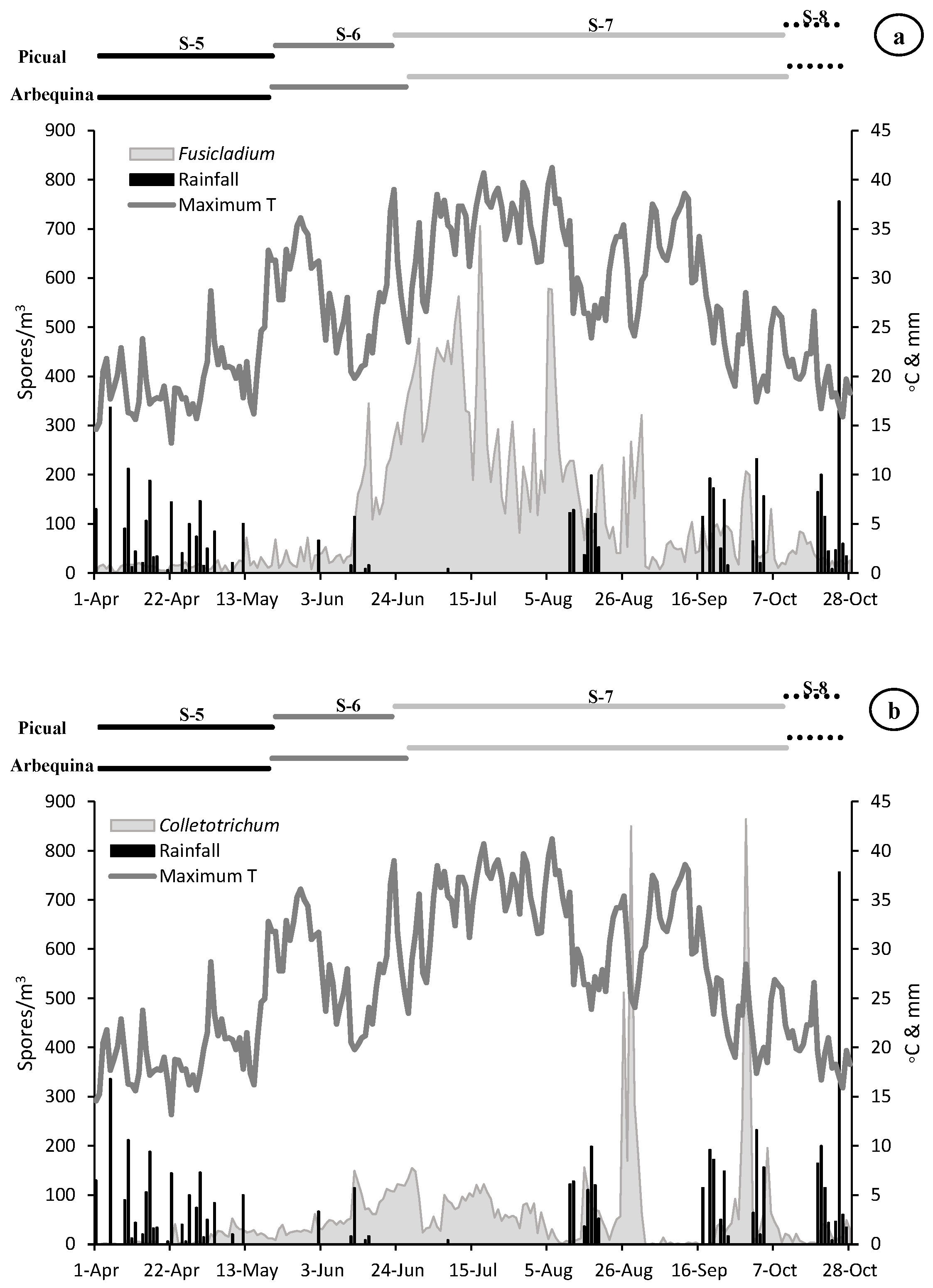
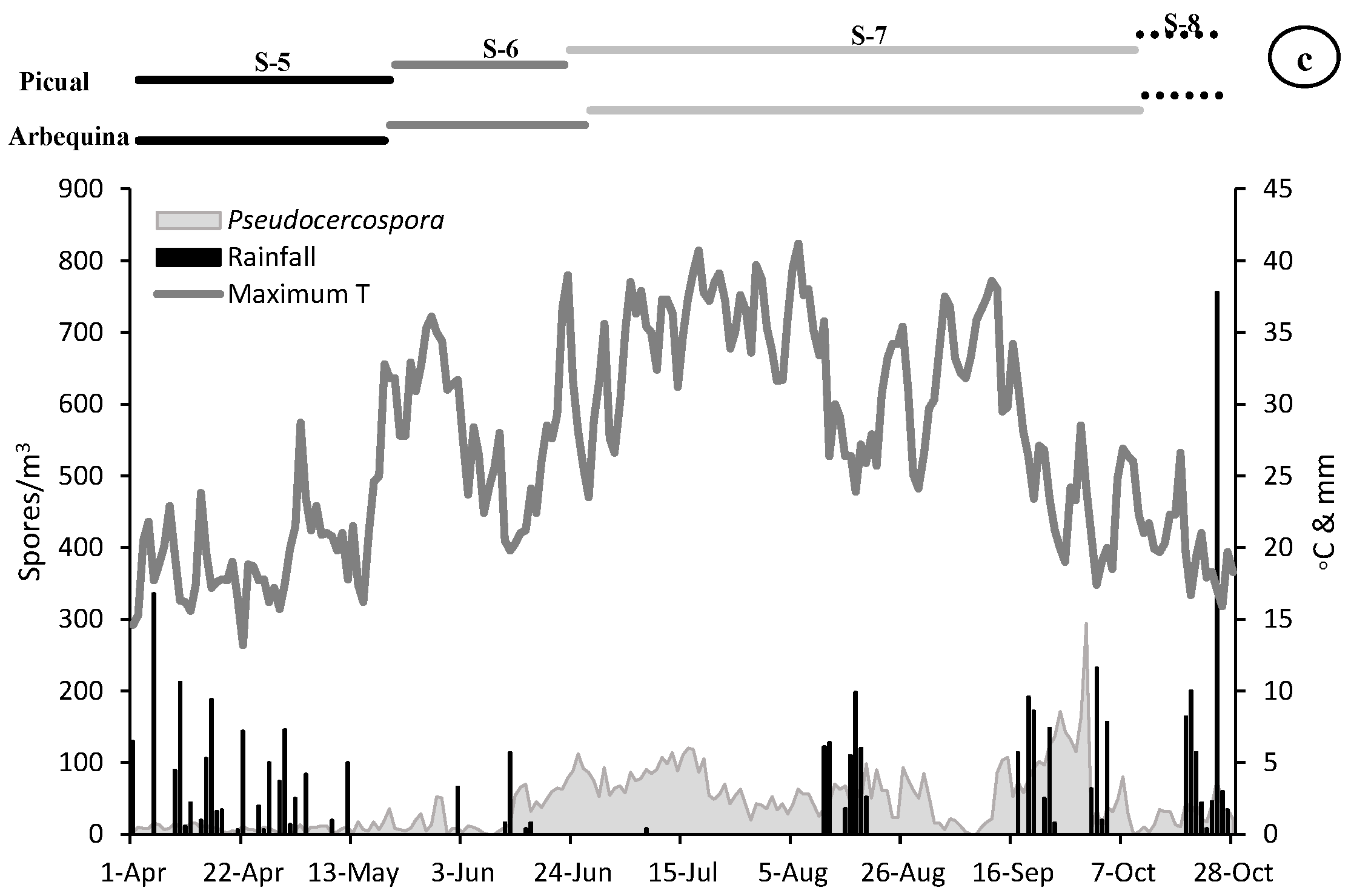
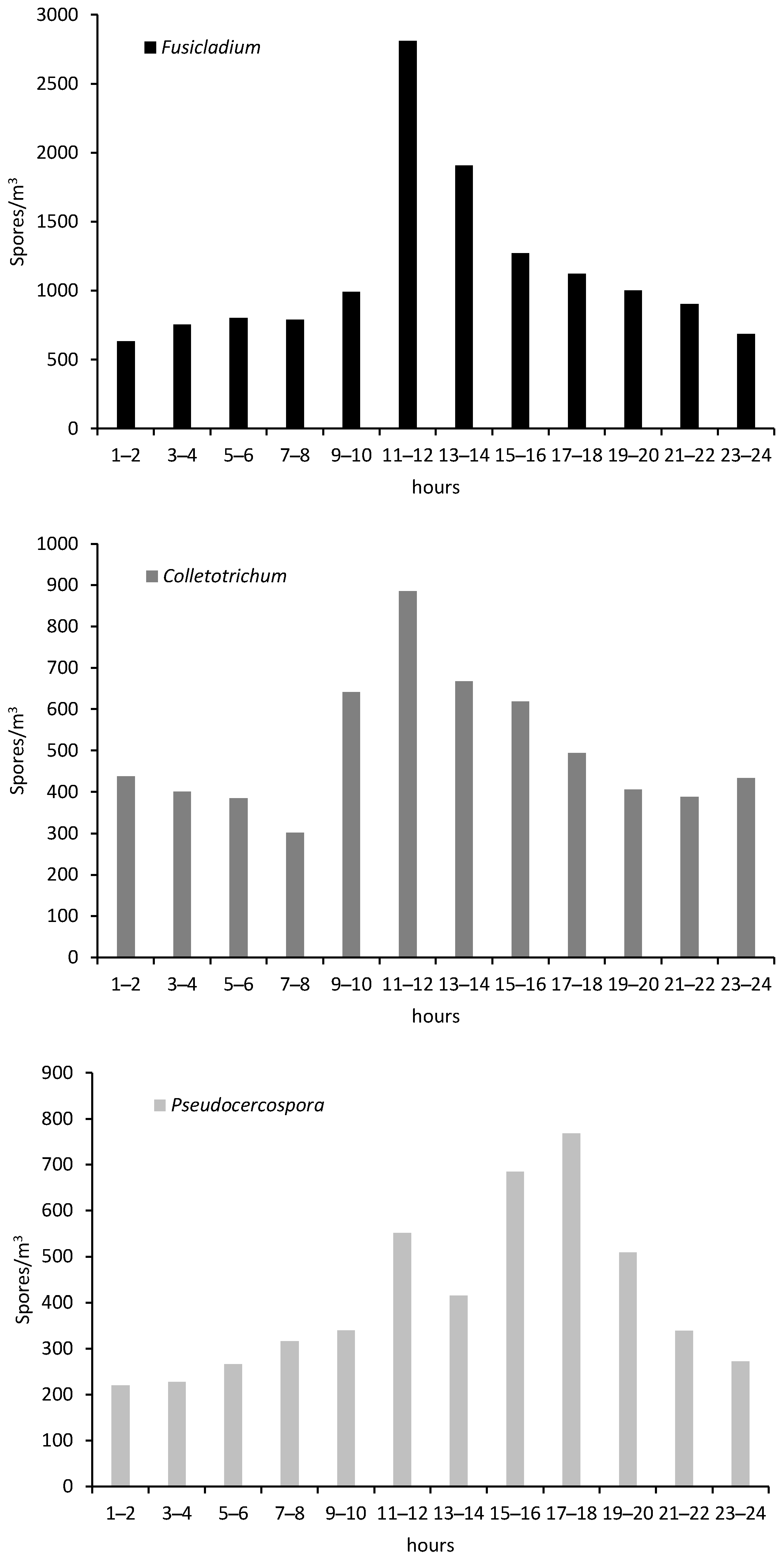
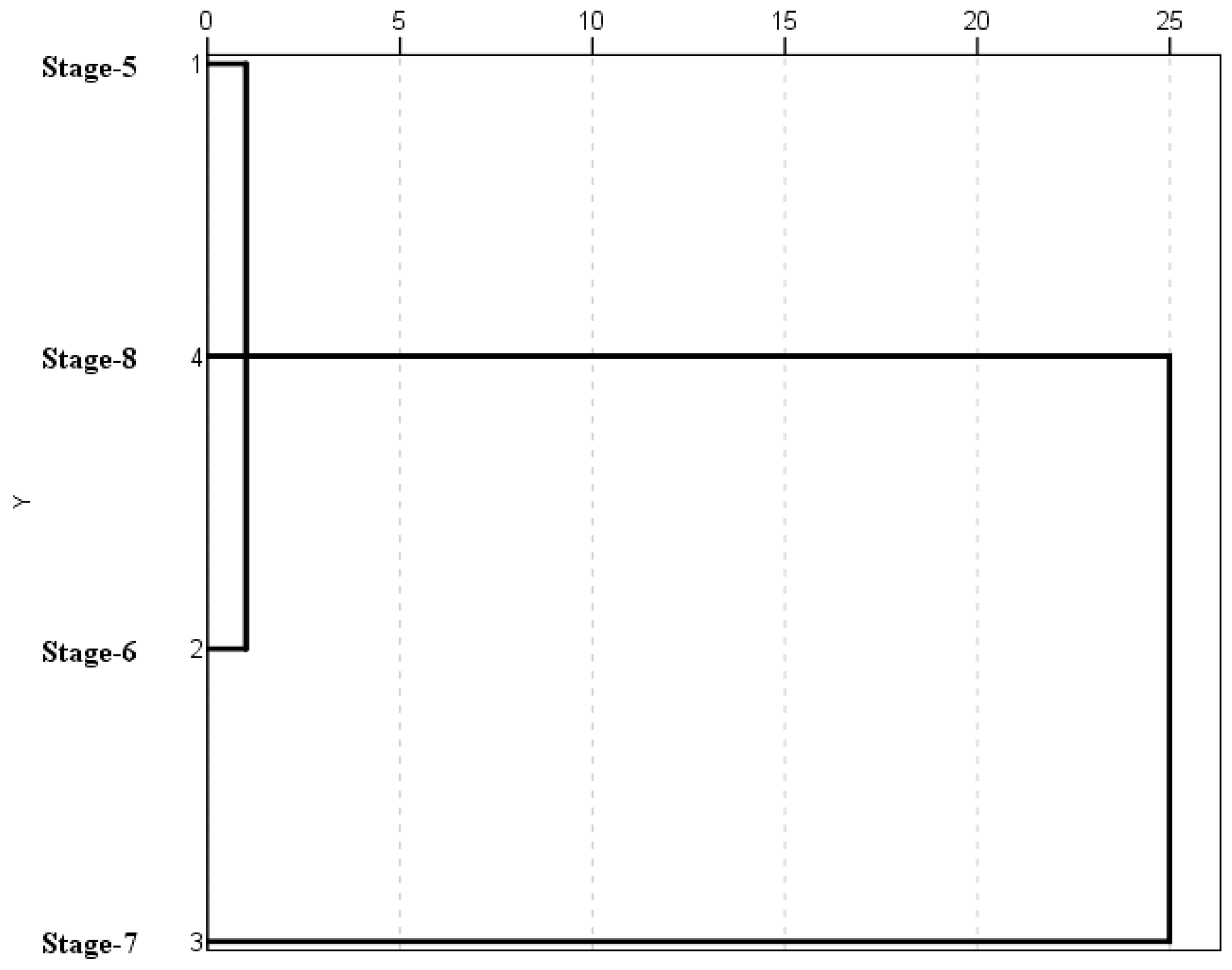
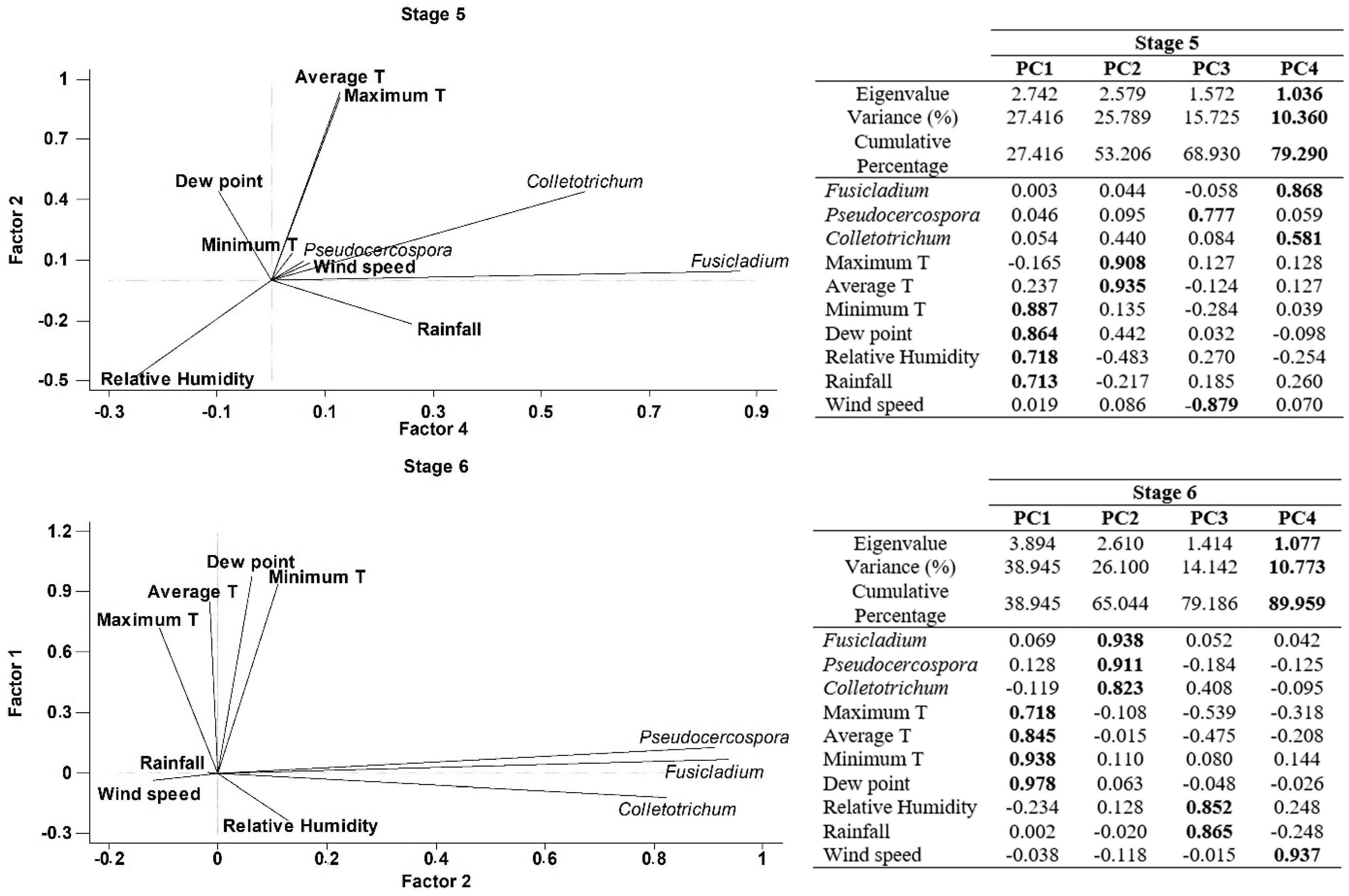
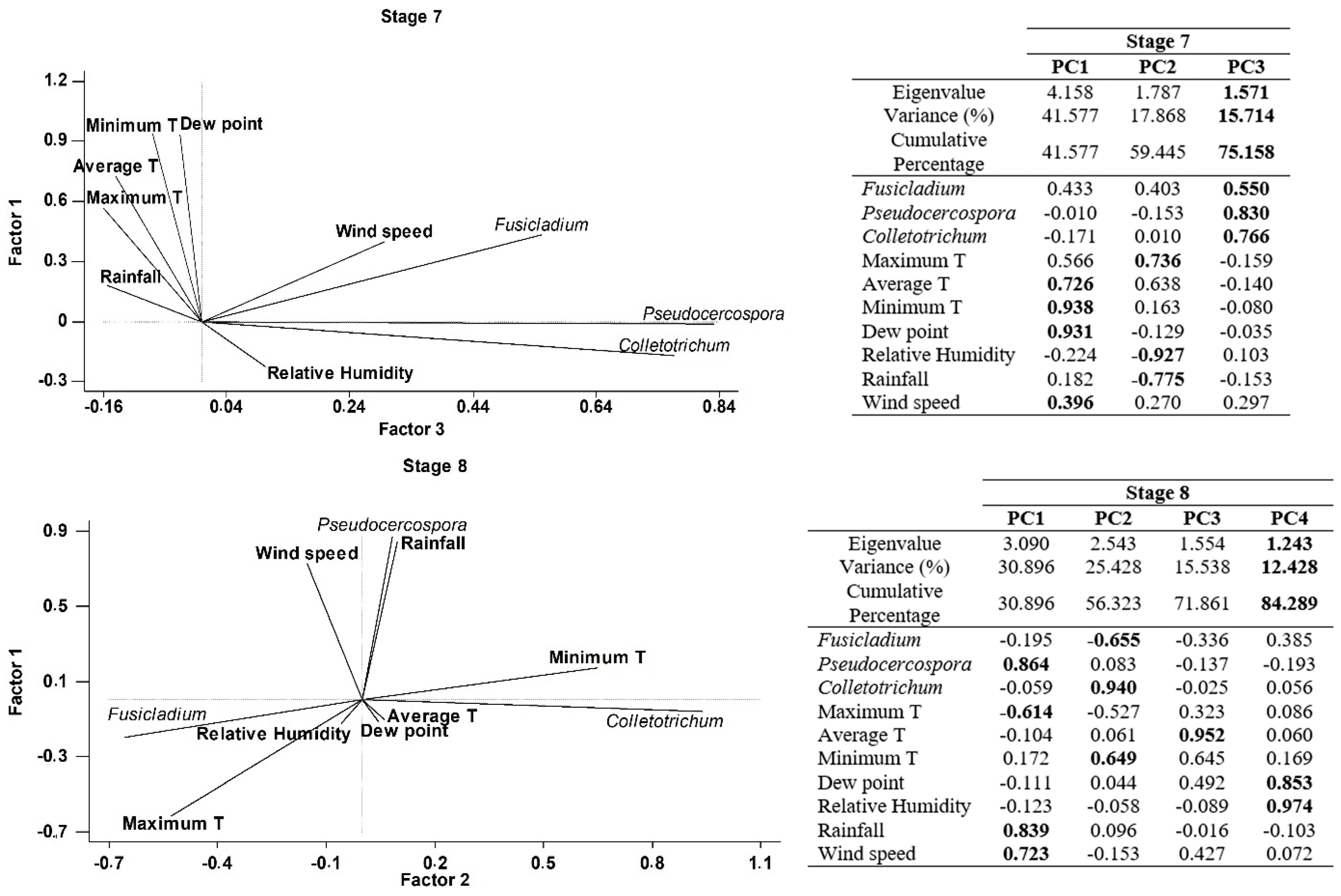
| Stage 5 | Stage 6 | Stage 7 | Stage 8 | Harvest | Total Lenght (Days) | ||
|---|---|---|---|---|---|---|---|
| Arbequina | Start | 31 March | 19 May | 27 June | 13 October | 29 October | 210 |
| End | 18 May | 26 June | 12 October | 28 October | |||
| Length (days) | 49 | 38 | 107 | 16 | |||
| Picual | Start | 31 March | 20 May | 23 June | 12 October | 29 October | 210 |
| End | 19 May | 22 June | 11 October | 28 October | |||
| Length (days) | 50 | 33 | 110 | 17 | |||
| Mean | Start | 31 March | 19 May | 25 June | 12 October | 29 October | 210 |
| End | 18 May | 24 June | 11 October | 28 October | |||
| Length (days) | 50 | 36 | 109 | 17 | |||
| S-5 | S-6 | S-7 | S-8 | ||
|---|---|---|---|---|---|
| Fusicladium | TOT | 713 | 3296 | 20,888 | 639 |
| Peak | 71 | 345 | 706 | 84 | |
| Peak date | 13 May | 16 June | 17 July | 14 October | |
| Colletotrichum | TOT | 520 | 2068 | 8548 | 284 |
| Peak | 53 | 150 | 865 | 49 | |
| Peak date | 9 May | 12 June | 29 August | 27 October | |
| Pseudocercospora | TOT | 393 | 1046 | 7068 | 508 |
| Peak | 17 | 88 | 294 | 77 | |
| Peak date | 17/14 May | 24 June | 30 September | 25 October |
| Stage 5 | Stage 6 | Stage 7 | Stage 8 | |
|---|---|---|---|---|
| Maximum Temperature | 21.36 | 28.58 | 31.08 | 19.8 |
| Average Temperature | 14.72 | 18.31 | 19.87 | 11.85 |
| Minimum Temperature | 9.67 | 13.44 | 15.27 | 8.93 |
| Dew Point | 9.61 | 12.8 | 13.87 | 7.54 |
| Relative Humidity | 74.36 | 73.95 | 73.54 | 76.7 |
| Rainfall | 155.3 | 8 | 96.4 | 69.4 |
| Wind Speed | 4.11 | 4.66 | 4.58 | 2.78 |
| Fusicladium | Colletotrichum | Pseudocercospora | ||||||||
|---|---|---|---|---|---|---|---|---|---|---|
| R | p | n | R | p | n | R | p | n | ||
| S-5 | Fusicladium | - | - | - | 0.371 ** | 0.009 | 48 | 0.223 | 0.128 | 48 |
| Colletotrichum | 0.371 ** | 0.009 | 48 | - | - | - | 0.064 | 0.666 | 48 | |
| Pseudocercospora | 0.223 | 0.128 | 48 | 0.064 | 0.666 | 48 | - | - | - | |
| MaxT | 0.062 | 0.676 | 48 | 0.440 ** | 0.002 | 48 | 0.015 | 0.920 | 48 | |
| AvgT | 0.174 | 0.236 | 48 | 0.427 ** | 0.002 | 48 | 0.007 | 0.960 | 48 | |
| MinT | 0.086 | 0.563 | 48 | 0.098 | 0.509 | 48 | −0.142 | 0.337 | 48 | |
| DewPoint | −0.029 | 0.842 | 48 | 0.075 | 0.612 | 48 | 0.077 | 0.603 | 48 | |
| RH | −0.275 | 0.059 | 48 | −0.341 * | 0.018 | 48 | 0.078 | 0.597 | 48 | |
| Rain | −0.037 | 0.804 | 48 | −0.046 | 0.759 | 48 | 0.005 | 0.974 | 48 | |
| WindSpeed | 0.117 | 0.427 | 48 | 0.135 | 0.359 | 48 | −0.324 * | 0.025 | 48 | |
| S-6 | Fusicladium | - | - | - | 0.720 ** | 0.000 | 37 | 0.691 ** | 0.000 | 37 |
| Colletotrichum | 0.720 ** | 0.000 | 37 | - | - | - | 0.512 ** | 0.001 | 37 | |
| Pseudocercospora | 0.691 ** | 0.000 | 37 | 0.512 ** | 0.001 | 37 | - | - | - | |
| MaxT | −0.187 | 0.268 | 37 | −0.455 ** | 0.005 | 37 | 0.108 | 0.525 | 37 | |
| AvgT | −0.123 | 0.469 | 37 | −0.371 * | 0.024 | 37 | 0.158 | 0.350 | 37 | |
| MinT | 0.084 | 0.622 | 37 | −0.116 | 0.493 | 37 | 0.148 | 0.381 | 37 | |
| DewPoint | 0.040 | 0.816 | 37 | −0.237 | 0.158 | 37 | 0.187 | 0.268 | 37 | |
| RH | 0.217 | 0.198 | 37 | 0.275 | 0.099 | 37 | −0.075 | 0.658 | 37 | |
| Rain | 0.147 | 0.385 | 37 | 0.216 | 0.200 | 37 | −0.057 | 0.739 | 37 | |
| WindSpeed | −0.134 | 0.429 | 37 | −0.063 | 0.713 | 37 | −0.349 * | 0.034 | 37 | |
| S-7 | Fusicladium | - | - | - | 0.512 ** | 0.000 | 109 | 0.467 ** | 0.000 | 109 |
| Colletotrichum | 0.512 ** | 0.000 | 109 | - | - | - | 0.495 ** | 0.000 | 109 | |
| Pseudocercospora | 0.467 ** | 0.000 | 109 | 0.495 ** | 0.000 | 109 | - | - | - | |
| MaxT | 0.400 ** | 0.000 | 109 | −0.076 | 0.429 | 109 | −0.094 | 0.332 | 109 | |
| AvgT | 0.433 ** | 0.000 | 109 | −0.011 | 0.907 | 109 | −0.062 | 0.519 | 109 | |
| MinT | 0.440 ** | 0.000 | 109 | 0.116 | 0.232 | 109 | 0.067 | 0.489 | 109 | |
| DewPoint | 0.336 ** | 0.000 | 109 | 0.095 | 0.326 | 109 | 0.152 | 0.115 | 109 | |
| RH | −0.339 ** | 0.000 | 109 | 0.084 | 0.386 | 109 | 0.143 | 0.139 | 109 | |
| Rain | −0.204 * | 0.034 | 109 | −0.133 | 0.168 | 109 | 0.054 | 0.579 | 109 | |
| WindSpeed | 0.474 ** | 0.000 | 109 | 0.280 ** | 0.003 | 109 | 0.084 | 0.384 | 109 | |
| S-8 | Fusicladium | - | - | - | −0.544 * | 0.024 | 17 | −0.266 | 0.302 | 17 |
| Colletotrichum | −0.544 * | 0.024 | 17 | - | - | - | 0.113 | 0.665 | 17 | |
| Pseudocercospora | −0.266 | 0.302 | 17 | 0.113 | 0.665 | 17 | - | - | - | |
| MaxT | 0.534 * | 0.027 | 17 | −0.489 * | 0.047 | 17 | −0.539 * | 0.026 | 17 | |
| AvgT | −0.198 | 0.446 | 17 | 0.104 | 0.693 | 17 | −0.160 | 0.540 | 17 | |
| MinT | −0.488 * | 0.047 | 17 | 0.545 * | 0.024 | 17 | 0.201 | 0.438 | 17 | |
| DewPoint | 0.146 | 0.576 | 17 | 0.152 | 0.559 | 17 | −0.328 | 0.199 | 17 | |
| RH | 0.453 | 0.068 | 17 | 0.113 | 0.667 | 17 | −0.252 | 0.328 | 17 | |
| Rain | −0.517 * | 0.034 | 17 | 0.351 | 0.167 | 17 | 0.719 ** | 0.001 | 17 | |
| WindSpeed | −0.211 | 0.415 | 17 | −0.038 | 0.884 | 17 | 0.317 | 0.215 | 17 | |
Publisher’s Note: MDPI stays neutral with regard to jurisdictional claims in published maps and institutional affiliations. |
© 2022 by the authors. Licensee MDPI, Basel, Switzerland. This article is an open access article distributed under the terms and conditions of the Creative Commons Attribution (CC BY) license (https://creativecommons.org/licenses/by/4.0/).
Share and Cite
Garrido, A.; Fernández-González, M.; Cortiñas Rodríguez, J.A.; Carrera, L.; González-Fernández, E.; Almaguer-Chávez, M.; Rodríguez-Rajo, F.J. Fungal Phytopathogenic Spore First Assessment in an Olive Orchard of Northwestern Spain. Agronomy 2022, 12, 246. https://doi.org/10.3390/agronomy12020246
Garrido A, Fernández-González M, Cortiñas Rodríguez JA, Carrera L, González-Fernández E, Almaguer-Chávez M, Rodríguez-Rajo FJ. Fungal Phytopathogenic Spore First Assessment in an Olive Orchard of Northwestern Spain. Agronomy. 2022; 12(2):246. https://doi.org/10.3390/agronomy12020246
Chicago/Turabian StyleGarrido, Alejandro, María Fernández-González, Jose A. Cortiñas Rodríguez, Lucía Carrera, Estefanía González-Fernández, Michel Almaguer-Chávez, and Fco. Javier Rodríguez-Rajo. 2022. "Fungal Phytopathogenic Spore First Assessment in an Olive Orchard of Northwestern Spain" Agronomy 12, no. 2: 246. https://doi.org/10.3390/agronomy12020246
APA StyleGarrido, A., Fernández-González, M., Cortiñas Rodríguez, J. A., Carrera, L., González-Fernández, E., Almaguer-Chávez, M., & Rodríguez-Rajo, F. J. (2022). Fungal Phytopathogenic Spore First Assessment in an Olive Orchard of Northwestern Spain. Agronomy, 12(2), 246. https://doi.org/10.3390/agronomy12020246









